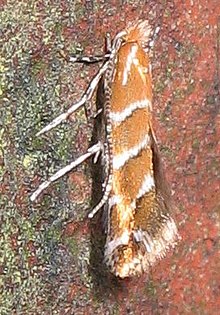Cameraria ohridella
| Horse-chestnut leaf miner | |
|---|---|
 |
|
| Scientific classification | |
| Kingdom: | Animalia |
| Phylum: | Arthropoda |
| Class: | Insecta |
| Order: | Lepidoptera |
| Family: | Gracillariidae |
| Genus: | Cameraria |
| Species: | C. ohridella |
| Binomial name | |
|
Cameraria ohridella Deschka & Dimić, 1986 |
|
The horse-chestnut leaf miner (Cameraria ohridella) is a leaf-mining moth of the Gracillariidae family. The horse-chestnut leaf miner was first observed in Macedonia in 1984, and was described as a new species in 1986. Its larvae are leaf miners on the common horse-chestnut (Aesculus hippocastanum). The horse-chestnut leafminer was first collected and inadvertently pressed in herbarium sheets by the botanist Theodor von Heldreich in central Greece in 1879.
Cameraria ohridella causes significant damage, mainly late summer browning, to the appearance of horse-chestnut trees. Despite the poor appearance of these infested trees, there is no evidence that damage by the moth leads to tree death. Seed weight, photosynthetic storage and reproductive capacity may however be reduced. Trees survive repeated infestations and re-flush normally in the following year. It appears that most of the damage caused by the moth occurs too late in the growing season to greatly affect tree performance. Consequently, there is no reason to fell and remove trees just because they are attacked by C. ohridella.
The larva feeds in a mine in the leaves of the tree, damaging the leaves and stunting growth. Infected leaves are covered in small brown patches which spread rapidly across the entire tree, giving an autumnal appearance. Eventually the leaves die and drop off; when new ones grow they are again infected. This cycle can repeat itself several times in one season.
The moth is up to 5mm long, with shiny, bright brown forewings with thin, silvery white stripes. The hindwings are dark grey with long fringes. Each female moth lays between 20 and 40 eggs singly on the upper surface of leaves, and once these hatch 2–3 weeks later, the larvae develop through five feeding phases (or instars) and two prepupal (spinning) phases before the pupal phase. The first stage creates a small cavity (or mine) parallel to a vein in the leaf and is "sap-sipping" rather than "tissue-feeding". By the third instar, the larva creates a mine approximately 8mm in diameter; this is further expanded by later instars until one mine can cover several square centimeters. The larva starts to pupate around four weeks after the egg hatches and, except when hibernating as a pupa in the mine, the adult emerges around two weeks later. In severe infestations, the mines of individuals can merge and almost the entire leaf area may be utilised. When this occurs it may lead to high moth mortality as the larvae compete for space and food. The moth is able to go through up to five generations each year, if the weather is hot and dry; on average in western Europe, the moth goes through three generations each year. The last generation of the year pupates for over six months so as to survive the winter. The pupae are extremely frost tolerant and have been recorded to survive temperatures as low as −23 °C (−9 °F). This allows its populations to increase even after hard winters.
...
Wikipedia
